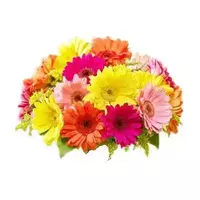Daisy flowers

The daisy (Bellis) is a small herbaceous plant that belongs to the family Asteraceae. Interestingly, all types of daisies can be either annual or biennial plants.
In the first year of the plant's life, a rosette of petiole leaves forms, from which numerous peduncle shoots appear. Daisy flowers collected in single baskets along the edge are female (pink or white), and in the middle - bisexual (yellow).
It is noteworthy that in the sun the flowers of the daisy open, and in rainy weather at night they close and delve. The fruit of the daisy is an oblong yellow achene. In our climate, the plant blooms in May-August. As a rule, daisies are grown to decorate flower borders, flower beds, flower beds and alpine slides.
The birthplace of daisies is West Eurasia, but today this plant is found wild in North America, as well as in New Zealand. In neighboring Ukraine, daisies grow in forest-steppe and forest areas, preferring clay soils.
The first information about the colors of the daisy can be found in Pliny the Elder - in the Middle Ages they were considered almost the most common healing plant. Indeed, the medicinal properties of the daisy were known to healers of those times (Leonard Fuchs, Adam Lonitzer, Jerome Bock). This plant was used for paralyzed limbs, gout, cramps, goiter, wounds, fever and pigment spots.
The active principle in the part of the plant that is located above the ground, that is, in the leaves and flowers of the daisy, is a complex of essential oils, bitters, saponins, tannins, flavonoids, anthoxanthines, organic acids and mucus. This determines the useful and tasteful properties of the daisy.
By the way, the daisy flowers themselves are distinguished by a nutty taste, thanks to which this plant finds its application in culinary affairs. Daisy flowers are perfectly combined with a variety of sweet dishes, but often they are seasoned with soups, salads and sandwiches, as well as used as decor for rice, spaghetti and other dishes. In addition, daisy petals are used as a filler for butter and cheese cream.
Types of daisies
In general, today science knows about 30 species of daisies that grow in the territory of Transcaucasia, Crimea, Western Europe, Asia Minor and even North Africa. Most of them are cultivated plants, but in the wild they can also be found quite often.
It is worth noting that according to the structure of inflorescences, all types of daisies are usually divided into two groups: tubular (V. r. var. fistulosa hort. ) and reed (V. r. var. ligunosa hort. ). Moreover, within both groups, plants differ, which differ in simple (non-charcoal), half-charcoal and terry inflorescences.
daisies flowers 0 kCal
Energy value of daisy flowers (Ratio of proteins, fats, carbohydrates - ju):
Proteins: 0 g (~ 0 kCal)
Fats: 0 g (~ 0 kCal)
Carbohydrates: 0 g (~ 0 kCal)
 Español
Español Français
Français Português
Português Русский
Русский 简体中文
简体中文 繁體中文
繁體中文 日本語
日本語 한국어
한국어 العربية
العربية Türkçe
Türkçe Қазақ
Қазақ Deutsch
Deutsch Italiano
Italiano Українська
Українська
